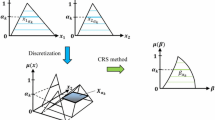Abstract
In this paper, a novel fuzzy structural analysis procedure based on the Jaya algorithm is presented. The Jaya algorithm is a simple, parameter-less optimization technique that is applicable for various kinds of optimization problems. Therefore, Jaya has gained significant attention from researchers. However, the applicability of Jaya in the domain of fuzzy structural analysis has not been addressed. The present study integrates Jaya in the α-cut level procedure to accurately capture the fuzzy response of a structural system. Moreover, two techniques, including the α-level subspace and the nearest neighbor comparison, are introduced to Jaya for reducing the computation burden. Some examples having non-monotonic behavior and a relatively large number of fuzzy parameters are employed to demonstrate the effectiveness of the Jaya-based fuzzy strategy.
Access this chapter
Tax calculation will be finalised at checkout
Purchases are for personal use only
Similar content being viewed by others
References
Zadeh, L.A.: Fuzzy set. Information Control 8(1), 338–353 (1965).
Moens, D., Hanss, M.: Non-probabilistic finite element analysis for parametric uncertainty treatment in applied mechanics: Recent advances. Finite Elements in Analysis and Design 47(1), 4–16 (2011).
Möller, B., Graf, W., Beer, M.: Fuzzy structural analysis using α-level optimization. Computational mechanics 26(6), 547–565 (2000).
Pham, H. A., Nguyen, X. T., Nguyen, V. H.: Fuzzy structural analysis using improved differential evolutionary optimization. In: Proceedings of the International Conference on Engineering Mechanics and Automation (ICEMA 3),pp. 492–498. Hanoi (2014).
Valdebenito, M. A., Pérez, C. A., Jensen, H. A., Beer, M.: Approximate fuzzy analysis of linear structural systems applying intervening variables. Computers & Structures 162, 116–129 (2016).
Anh, P. H.: A fast fuzzy finite element approach for laterally loaded pile in layered soils. Journal of Science and Technology in Civil Engineering (STCE)-NUCE 12(3), 1–9 (2018).
Pham, H. A., Truong, V. H., Tran, M. T.: Fuzzy static finite element analysis for functionally graded structures with semi-rigid connections. Structures 26, 639–650 (2020).
Pham, H. A., Truong, V. H., Vu, T. C.: Fuzzy finite element analysis for free vibration response of functionally graded semi-rigid frame structures. Applied Mathematical Modelling 88, 852–869 (2020).
Rao, R.: Jaya: A simple and new optimization algorithm for solving constrained and unconstrained optimization problems. International Journal of Industrial Engineering Computations 7(1), 19–34 (2016).
Rao, R.: Jaya: An Advanced Optimization Algorithm and its Engineering Applications. Springer (2019).
Pham, H. A.: Reduction of function evaluation in differential evolution using nearest neighbor comparison. Vietnam Journal of Computer Science 2(2), 121–131 (2015).
Möller B., Beer, M.: Fuzzy Randomness: Uncertainty in Civil Engineering and Computational Mechanics. Springer (2004).
Author information
Authors and Affiliations
Corresponding author
Editor information
Editors and Affiliations
Rights and permissions
Copyright information
© 2022 The Author(s), under exclusive license to Springer Nature Singapore Pte Ltd.
About this paper
Cite this paper
Pham, HA. (2022). Jaya-Based Fuzzy Structural Analysis. In: Ha-Minh, C., Tang, A.M., Bui, T.Q., Vu, X.H., Huynh, D.V.K. (eds) CIGOS 2021, Emerging Technologies and Applications for Green Infrastructure. Lecture Notes in Civil Engineering, vol 203. Springer, Singapore. https://doi.org/10.1007/978-981-16-7160-9_34
Download citation
DOI: https://doi.org/10.1007/978-981-16-7160-9_34
Published:
Publisher Name: Springer, Singapore
Print ISBN: 978-981-16-7159-3
Online ISBN: 978-981-16-7160-9
eBook Packages: EngineeringEngineering (R0)




